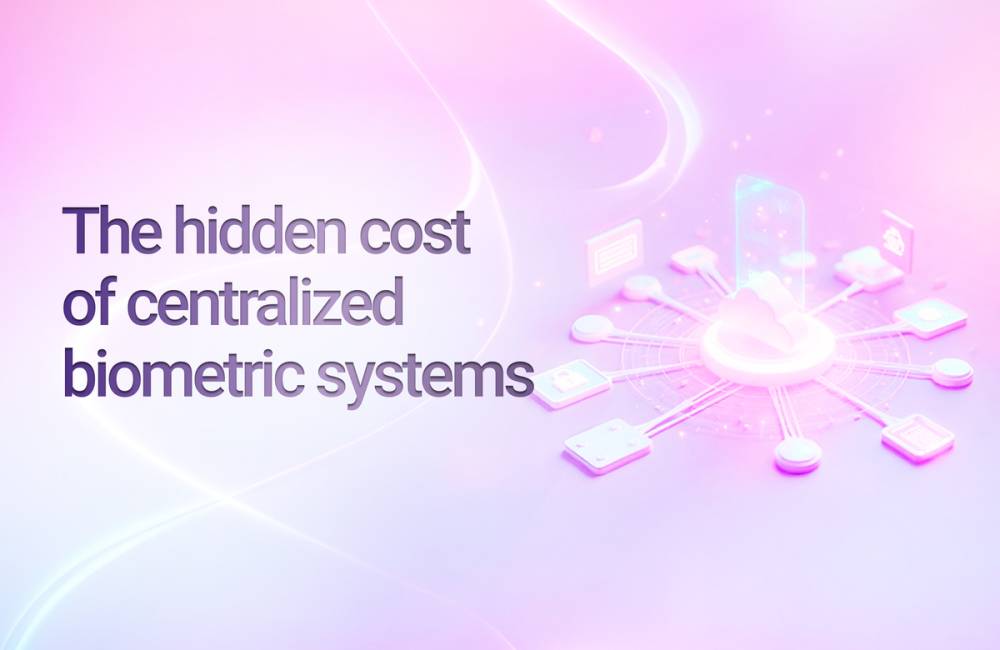The hidden cost of centralized biometric systems is bigger than you think Written on

Customer data is one of the most sensitive assets an organization can manage. When it's exposed, the damage extends far beyond the technical perimeter, eroding user trust, triggering regulatory scrutiny, and introducing long-term business risk.
Centralized biometric systems may appear efficient. They consolidate identity management, promise seamless user experiences, and reduce friction at scale. But behind the slick interfaces and streamlined onboarding lies a fragile foundation: one that creates single points of failure, magnifies attack surfaces, and puts data at permanent risk.
This article dives into the true cost of centralized biometric systems. Not just the immediate financial or legal consequences of a breach, but the long-term operational, ethical, and reputational toll that often goes unnoticed.

Biometrics don’t lie, but systems do
Centralized biometric systems are identity infrastructures where biometric data is collected and stored in a single, unified database. These systems are typically implemented by large institutions like banks, telcos, and enterprises looking to streamline authentication, reduce fraud, and enhance user onboarding.
On paper, centralized biometric databases seem like a no-brainer for scalability and control. They offer a clear, consolidated view of user identities, promise faster authentication processes, and can be integrated across services with relative ease. For organizations juggling compliance and security concerns, centralization often feels like the safest bet.
But centralization comes with trade-offs. Beneath the surface, these systems introduce significant risk exposure that can compromise user trust, increase operational burden, and turn a well-intentioned security solution into a ticking liability.
When you centralize identity verification, you create a single, high-stakes point of failure. One breach is all it takes to blow open a vault of customer data and the fallout isn’t just financial.
The risk doesn’t end with hacking. Centralized systems are vulnerable to internal misuse, regulatory scrutiny, and dangerously opaque data practices. Ask yourself: who really owns the data you're collecting? Who controls the user’s digital identity: you, or a third-party vendor? If you can’t answer that clearly, you’ve already lost control. And if that doesn’t set off alarm bells, it should.
Yes, biometrics don’t lie. They remain one of the most secure ways to verify identities and grant access to services and accounts. But the centralized systems behind them? They’re the weak link: opaque, brittle, and built on a dangerous illusion of control.
When the breach becomes a crisis
When centralized biometric systems fail, they don’t fail quietly. The financial and reputational consequences of a centralized biometric breach ripple far beyond the IT department, hitting legal teams, PR, compliance, customer support, and ultimately, the boardroom.
The direct costs are substantial: investigations, infrastructure overhauls, breach notifications, regulatory fines, and potential litigation. Depending on the industry and jurisdiction, a single incident can trigger penalties under GDPR, CCPA, or other data protection frameworks, especially when sensitive, non-revocable data like biometrics is involved.
But the indirect costs often run deeper. Customers lose trust. Partners question reliability. Talent becomes harder to attract. Investor confidence wavers. In sectors where identity and security are core to the brand promise, like banking and fintech, a breach can erode years of reputation in a matter of days.
And because biometric data is permanent, the impact isn’t contained to a single incident. Organizations may be forced to invest heavily in long-term risk mitigation strategies (often reactive, fragmented, and costly) just to manage the lingering effects of a compromised system.
In short: the true cost of a centralized biometric breach is rarely accounted for upfront. When it hits, it demands attention at every level of the business.
There is a better way: Decentralized identity
The solution doesn’t lie in adding more layers of security to a flawed model. It lies in rethinking the model entirely.
Decentralized identity offers a fundamentally different approach. Instead of storing biometric data in a central repository, decentralized systems allow users to hold and control their own identity credentials locally, often on their devices. Authentication can still rely on biometrics, but the data never leaves the user’s control or becomes part of a centralized database vulnerable to mass exploitation.
This shift addresses the core vulnerabilities of centralized models:
-
Privacy: No need to share or store sensitive biometric data in third-party systems.
-
Security: Eliminates single points of failure and reduces the overall attack surface.
-
Control: Empowers users to decide when, how, and with whom they share their identity.
We’re already seeing early adoption of this approach in sectors where trust and compliance are critical. Some banks are piloting decentralized identity solutions to streamline KYC processes without storing sensitive biometric data. In the payments space, it is being explored as a way to authorize high-value transactions securely, without exposing personal data unnecessarily.
These aren’t experiments in theory — they're signals of where digital identity is heading. And they prove that privacy and usability no longer need to be trade-offs.
Rethinking risk, redefining trust
Centralized biometric systems were built on the promise of control, but that control is proving increasingly fragile. As the risks compound (security breaches, regulatory exposure, operational costs) it’s clear that the model itself needs rethinking.
The future of identity isn’t about more centralization. It’s about smarter architecture, privacy by design, and giving users real agency over their data. Decentralized identity offers a viable, scalable alternative one that reduces exposure, restores trust, and aligns with the security expectations of a digital-first world.
If your organization is serious about preventing ID fraud without compromising user experience or long-term trust, now is the time to explore a different path.
📘 Download our latest eBook, From Risk to Trust: Decentralized Verification for ID Fraud Prevention, and discover how privacy-first identity architecture can turn risk into resilience.






